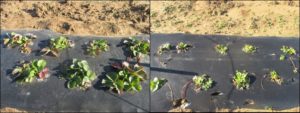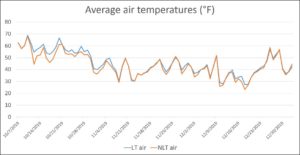Strawberry production with the annual plasticulture system is successfully used in southern states. Plug plants are planted in fall and strawberries are harvested in spring the next year. The planting is usually not carried over to crop a second year. Compared with matted row system, annual plasticulture system has advantages such as easier weed and disease management and faster crop harvest after planting. Strawberry growers in Indiana are interested in annual strawberry production, but experiments have shown using this system is challenging in Indiana because of lower fall temperatures compared with southern areas that have a long, warm fall. That makes it difficult to achieve adequate yield that compensate the production cost.
Tunnel systems including high tunnels and low tunnels are widely used to extend the production season of many vegetable crops. Can the systems be used on strawberries and make the annual production system feasible in Indiana? Research trials were initiated at Southwest Purdue Agricultural Center to evaluate annual strawberry production under different tunnel systems. This article provides an update for a trial using low tunnel system for the fall planted strawberry plants (Figure 1).
Strawberry plugs were planted on Sep. 10, 2019. Low tunnels were used from Oct. 10 to Jan 2. Figure 2 is a comparison of plants grown under low tunnels and without low tunnels. The picture was taken after low tunnels were removed in early Jan. larger canopy size was observed for plants grown under low tunnels for most varieties. Figure 3 shows the recorded temperatures with and without low tunnels.

Figure 2. Picture on the left shows the size of strawberry plants grown under a low tunnel from Oct. 10 2019 to Jan. 2, 2020. Picture on the right shows the size of strawberry plants grown without a low tunnel during the same period.

Figure 3. Daily average air temperatures with low tunnels (blue line) and without low tunnels (red line)
To better understand what the difference in temperatures and plant sizes mean in regard to crop yields, we will review a few important strawberry physiological facts.
Yield is directly determined by the number of inflorescences. Inflorescences develop at the terminal growing point of crown. Therefore, the number of crowns determine the level of yield. When the plugs are first planted, they have a small crown with axillary buds. As the crown grows bigger, axillary buds may develop into runners, branch crowns or leaves depending on the environment. Environmental conditions play a role in determining the fate of each axillary bud. For short-day cultivars, day length shorter than 14 h (from end of August to end of April in southern Indiana) is an essential factor for developing branch crowns and inflorescences. Temperature is another important factor. Crowns develop at temperatures above 50°F and inflorescences develop at temperatures less than 59°F.
Reviewing the recorded temperatures this past fall, ideal conditions for developing branch crowns lasted throughout October. Low tunnels provided a clear advantage for plant growth. On average, they increased temperatures about 4 degrees. Temperatures dropped very quickly last fall, and temperatures were below 50 °F during most of November and early December, regardless of using low tunnels or not. As a result, the advantage of using low tunnels this past year may be limited.
Our consideration for removing low tunnels in early January is to prevent plants from blooming too early in the spring. We covered the beds with floating row covers (winter protection) at the time when low tunnels were removed. Floating row covers were removed in early March. Currently, plants are actively growing with no flower buds visible yet.
We will continue provide update about this trial and answer the question about Will Low Tunnels Make a Difference in Annual Plasticulture Strawberry Production?
